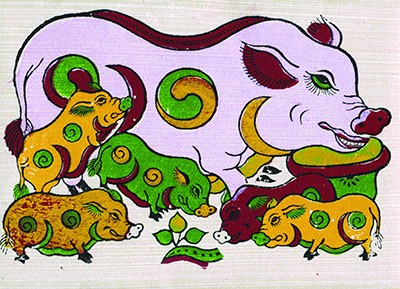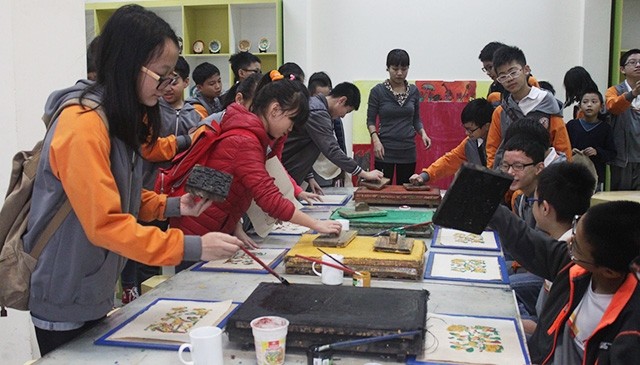(VOVWORLD) - Dong Ho paintings or Vietnamese woodblock prints refers to Vietnamese folk art originating in Dong Ho Village, Bac Ninh Province, with a history spanning hundreds of years. The folk art was recognized as a national intangible cultural heritage in 2013. Vietnamese authorities are compiling a dossier to seek UNESCO recognition of Dong Ho paintings as an intangible cultural heritage of humanity that needs urgent safeguarding.
 Dong Ho painting "Pigs" Dong Ho painting "Pigs"
|
Dong Ho paintings, which date back to the 16th century, have been done manually, from making papers to woodcut printing. The craft particularly flourished from the late 19th century to the mid 20th century, during which all 17 clans of the village made folk paintings. The market for Dong Ho folk paintings is especially busy during the 12th lunar month. Locals have a saying for this: “Wherever you are, remember to return to the village in the 12th lunar month to trade paintings”.
Dong Ho paintings are printed on Do or poonah paper, which is made from the powder of Do trees. The papers are then coated with a layer of paste or pine resin mixed with shells, creating a bright and slightly glittery background. 60-year-old Nguyen Thi Oanh has made folk paintings for nearly 50 years. Oanh said five main colors are used in the paintings: black, green, indigo, red and yellow. The colors are made of natural materials so they are very strong and vibrant.
“Red is created from the powder of ocher or bricks. Black is made from a powder mixture of ash from bamboo leaves or straw and paste. Yellow is taken from flowers, and green is extracted from soft trees. All the colors are as natural as the natural colors of local flowers and trees.”, said Ms. Oanh.
Dong Ho folk paintings feature 180 topics in 5 categories: worship, history, blessings, daily use and story telling. The topics the paintings are based on people’s daily activities and production. They portray legendary characters, landscapes, and activities that imply their wishes for happiness, wealth, bountiful crops and effective husbandry. That’s why Dong Ho paintings were a decorative favorite during Tet or Lunar New Year holidays.
 Students are instructed to make Dong Ho paintings Students are instructed to make Dong Ho paintings
|
The tradition has faded rapidly under the overwhelming dominance of Vietnam’s modernization. As a result, only several households in the village still make pictures, including those of artisans Nguyen Dang Che, Nguyen Huu Sam, and Tran Nhat So, while many others, around 90% of the village’s total 400 households, have switched to producing joss paper and votive paper objects.
"The compilation of a dossier asking UNESCO to add Dong Ho paintings into the list of intangible cultural heritages that need urgent safeguarding is of great importance. It aims to better preserve and promote the village’s craft as well as raising the local people’s awareness in this effort.", said Nguyen Huu Viet, a folk painting researcher and collector,